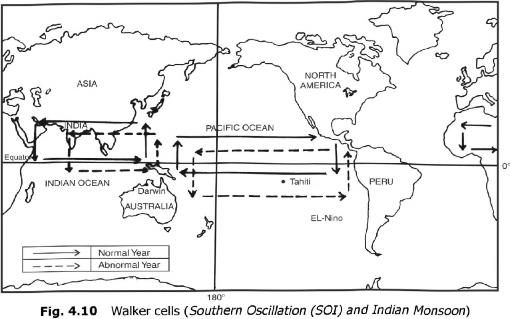EL-NINO AND THE INDIAN MONSOON
The Indian monsoon is also influenced by EL-Nino, Southern oscillation and Somalian ocean current. El-Nino, meaning “Child Christ”, is a warm ocean current appearing along the Peru coast, generally in December. It replaces the cold Peru Ocean Current flowing along the Peru coast in normal years. Under normal conditions, the Peru is a cold water current, while over the western Pacific, (Indonesia and eastern Australia) the ocean current is warm and deep (Fig. 4.10). The appearance of El-Nino 'reverses the condition’there, and develops warm conditions over the eastern Pacific (Peru coast) and cold conditions in the western Pacific (east of Australia and Indonesia). Whenever this usually warm ocean current (El-Nino) is produced near the Peruvian coast, the amount of precipitation in the coastal areas of South America is usually high, while the eastern coasts of Australia and Indonesia record drought conditions. In brief, the occurrence of El-Nino results into a weak monsoon causing drought, floods and failure of crops.
The Southern Oscillation (SOI) is the name ascribed to the seesaw pattern of meteorological changes that are often observed between the Pacific and the Indian Oceans. It has been observed that whenever the surface pressure is higher over the Pacific, the pressure over the Indian Ocean tends to be low. As pressures are inversely related to rainfall, this suggests that w'hen low pressure prevails over the Indian Ocean in the winter months (positive Southern Oscillation) the chances are that the coming monsoon rains will be good. In opposition to this, when high pressure prevails over the Indian Ocean in winter season, the coming monsoon will be weak. The term Southern Oscillation was discovered by Sir Gilbert Walker, the first Director General of the Indian Meteorological Service in 1924.
The oscillation has a period varying from 2-7 years. The intensity of Southern Oscillation (SOI) is measured by the differences in sea level pressures at Tahiti (18°S and 149°W), a station in the mid-Pacific, and Port Darwin (12°S and 130°E), a representative station in the Indian Ocean (Walker Cell, Fig. 4.10) A negative value of Southern Oscillation Index (SOI) implies low pressure over Peru Current and higher pressure over north Indian Ocean during the winter season and a poor or indifferent monsoon. Thus, there is a close relationship between the appearance of El-Nino and negative SOI. The low and negative phase of the Southern Oscillation in combination with El-Nino is called ENSO event.

As stated above, the Southern Oscillation is closely linked with the Walker Circulation. With a high positive Southern Oscillation, there would be a zone of low atmospheric pressure over Australia and Indonesian Archipelago. It will be accompanied by large convective clouds, heavy rainfall and raining air motion. This air eventually runs eastward, and after traversing the Pacific as a high level westerly wind at 200 mb, it descends over South America.
In terms of global winds, the Walker circulation suggests a strong belt of convergence between the trade winds of both the hemispheres at a location slightly to the north of the equator. These trade winds pile up a huge quantity of warm water in the western Pacific, produce equatorial counter-current from the Indonesian coast and facilitate upwelling of cold water from below, near Peru coast, giving rise to cold Peru current. Hence, high positive value of Southern Oscillation (SOI) indicates:
(i) a cold Peru current,
(ii) strong trade winds,
(iii) accumulation of water in western Pacific which is balanced by the Equatorial Counter Current and under current,
(iv) a rise in the depth of thermo-cline as we proceed from the western half of the Pacific, and
(v) an ascending branch of the Walker Circulation over Australia and Indonesia with its descending branch over South America (Fig. 4.10). Such a normal condition leads to a normal southwest monsoon.
The appearance ofEl-Nino leads to a ‘warm phase’of the Pacific or negative Southern Oscillation (SOI). Now, the ascending branch of the Walker Cell shifts to the central regions of the Pacific Ocean and the descending air branch to the south-eastern parts of the ocean (Fig. 4.10). As upwelling-off the South American coast decreases, the sea surface temperature rises. This leads to weaker trade winds, less accumulation of warm water on the western half of the Pacifrc Ocean, weakening of the Equatorial under current, heavy rain and floods along the South American coast and poor monsoon or monsoon failure over the subcontinent.
